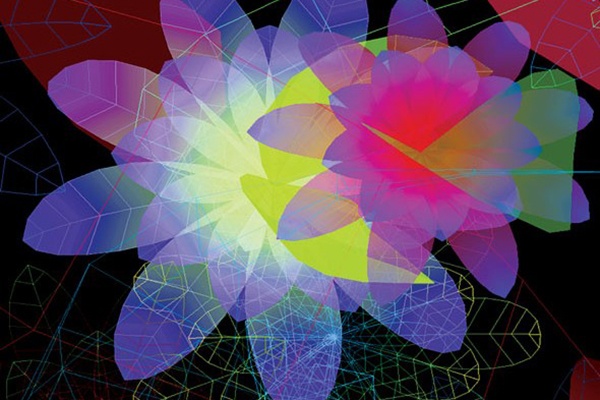
Ultra-Nature

Ultra-Nature
- Pittsburgh Cultural Trust
- Wood Street Galleries
SHOW TITLE: Ultra-Nature
ARTIST: Miguel Chevalier
CURATOR: Murray Horne
The artist Miguel Chevalier is known internationally as one of the pioneers of virtual and digital art. His images are a rich source of insight into ourselves and our relationship to the world.
Ultra-Nature is a lush virtual garden that was created for Sejul Gallery, Korea. The garden’s flora is made up of eight varieties of luminescent, scalar plants, ranging from herbaceous vegetation and bright yellow flowers with turquoise stems, through to cacti in shades of red and violet. Each plant evolves according to a unique cycle that is defined by its morphogenetic characteristics. Motion sensors allow visitors to influence the growth of the garden’s plants. As viewers interact with the artwork, the plants incline to the left or right, creating a scene that alternates between baroque strapwork and stylized organic ballet. In this way, they mirror Monet’s cosmic sensibility, his evocation of light and time as well as his taste for series (as in Nymphéas water lily).
The desert landscape, RGB Land, which regularly moves towards us, could be filmed by a drone, or seen by a bird of prey that glides unperturbed by the sight of a moving animal. This could be in Arizona or New Mexico, but it is neither. Everything, the earth, the water, the sky, comes from the calculations of machines, the computation of algorithms and fractal models.
We endlessly move towards infinity in this procedural landscape that envelops us. However, we are only exploring a tiny part of a world that has been globally mapped. The gigantic map, which looks like a seismic study, precedes the existence of this region that is nothing more than an extrapolated detail. Consequently, it is the map that makes the territory and not the other way around.
The framing, just like the image’s sharpness, evokes panoramic photography, which, as early as the second half of the nineteenth century, placed the viewer in an immersive situation. Our eyes are impossibly attracted to the far distance, just like when we contemplate the paintings of Gaspard David Friedrich.
The singularity of this landscape also resides in the saturated colors – reds, greens and blues – that cover it. This covered landscape evokes Robert Smithson’s Earthworks. But, here, the rain is not at all a threat to the artifice. This artificial nature has already succumbed to fractal erosion. It now appears to us frozen in its movement.
Accessibility:
-
For personal assistance selecting accessible seats or for more information about accessibility
for a person with a disability, please contact Customer Service at
412-456-6666
- Wood Street Galleries
-
601 Wood Street
Pittsburgh PA 15222